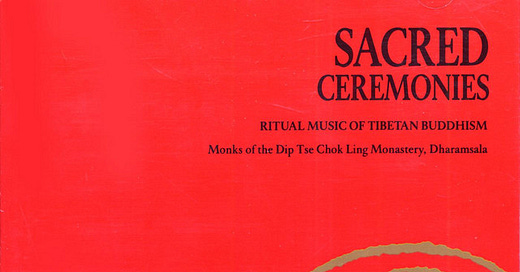Genre of the Day - Tibetan Buddhist Chant
Album of the Day - Sacred Ceremonies: Ritual Music of Tibetan Buddhism by the Monks of the Dip Tse Chok Ling Monastery, Dharamsala (1996)
Though the winter holiday cycle has a wonderful way of lightening the load, this time of year is still marked by the shortest days as the dredges of winter first begin to truly sink in. I reflect on how everybody seems to be going through things and experiencing joy, hopefully in a positively balanced measure, and hope that everybody can find a way to cope with the metaphorical and literal darkness that can loom larger these months. Music is certainly one of the best tools; I find that it can draw out my emotions, give them a safe harbor, and send them back to sea to give me peace. I often think of how Tina Turner, during the worst of her abuse at the hands of Ike Turner, turned to Buddhist practices and would chant the phrase “nam-myoho-renge-kyo” for hours at a time every day. Today, we further delve in Buddhist religious practices, centered on Tibet’s religious music.
Though Buddhism encompasses many branches with spiritual centers across different countries, Tibet is globally recognized as a center of the religion; 80% of its population is estimated to follow the religion, the branch is headed by the Dalai Lama as the international figurehead of Buddhist thought, and it plays hosts to some of largest monasteries in the world. Since Tibet was annexed by modern China in 1951, exile has given the branch a newfound spiritual exigency. Masters like Chögyam Trungpa have played an instrumental role in imparting its practices to audiences worldwide, such as in the founding of Naropa University in Boulder, Colorado which lies just about an hour from me. Tibetan Buddhist chants vary from popular notions of Buddhism, and listening can help us gain insight into a faith that western conceptions tend to shroud in a near-celestial mystique.
Tibetan Buddhist chants are always sung by groups of monks, rather than solo singing, speaking both to the depth of connection between the thousands of monks who might live at a single monastery and to the necessity of monasteries to act as centers of resistance, fighting for Tibetan religious autonomy even in the face of state suppression. Chants are drawn from many hundreds of texts, with particular monasteries favoring certain passages. The prime acoustics of life at the highest elevation, voices sweeping down vast valleys, seems to always inspire unique singing styles. Tibetan chants are characterized by extremely low overtone singing, in which a single singer's voice produces two tones as a result of secondary resonance in the mouth due to the low notes’ vibrations. Chants’ melodies fall into three types, each ranging in complexity from the relatively simple dön to the yang which mirrors western pitch intervals and the holiest, slowest dang. Though there are notations for dang melodies, each monastery has some leeway as to how they interpret and sing them in ritual.
Even as the monks probe the deepest depths of their voices, the instrumental accompaniment in the form of the foreboding sound of the dungchen horn, whose sound resembles the cries of elephants, and the smaller, gold-plated gyaling trumpet descend where the human voice can’t go. Tibetan chant also employs percussion, including several chimes and the khar-nga gong. Curiously, the singing bowls often linked to Tibet appear to be a western sensationalization of Tibetan mysticism rather than an actual facet of its music, as their presence is not recorded in traditional chant and they originate instead from northern India. That’s one mystery uncovered, without even having done a chant yet!
Today’s album by the 25 monks of the Dip Tse Chok Ling Monastery contains music unlike any that I’ve ever heard, blindsiding me with its sheer power and sonic stature. Once you turn on the first chant, it’s almost impossible to do anything else—I’ve never heard so many voices capable of dipping so low at once, as if a metaphor for the metaphysical realms they discuss and explore all their lives. Kilometer-high horns and sudden percussion thunder in after vocal passages, surely notching an 8.5 on the Richter scale. How these monks summon such vocal power drawing breath from the oxygen-thin air of high mountain plateaus like the extended, tonally resonant and stunning drones at the end of “Sangva Duta” is astounding. That strength stems from the monastery’s history being razed and exiled amidst the purging of thousands of religious sites in Tibet throughout the 20th century; the role of music here is both inwards, to enhance one’s worship and understandings, and as a recording, to showcase a tradition with transcendent intensity.







Polyphonic throat singing is also one of the most metal things that exists.